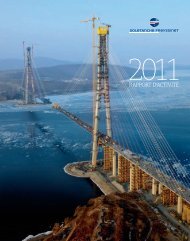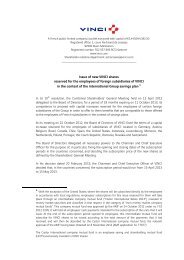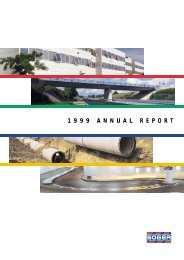VINCI - 2005 annual report
VINCI - 2005 annual report
VINCI - 2005 annual report
You also want an ePaper? Increase the reach of your titles
YUMPU automatically turns print PDFs into web optimized ePapers that Google loves.
CONSOLIDATED FINANCIAL STATEMENTS<br />
23. RETIREMENT AND OTHER EMPLOYEE BENEFIT OB-<br />
LIGATIONS<br />
The provisions for retirement and other employee benefit obligations<br />
amounted to €723.9 million at 31 December <strong>2005</strong> (including the<br />
part at less than one year of €654.0 million) against €713.1 million<br />
at 31 December 2004 (including the part at less than one year of<br />
€677.6 million). These comprise on one hand provisions for retirement<br />
23.1 RETIREMENT BENEFIT OBLIGATIONS<br />
The provisions for retirement benefit obligations amount to €667.4<br />
million at 31 December <strong>2005</strong> (including the part at less than one year of<br />
€63.9 million) against €658.6 million at 31 December 2004 (including<br />
the part at less than one year of €25.9 million). They cover provisions for<br />
both lump-sums on retirement and also supplementary defined benefit<br />
retirement plans.<br />
<strong>VINCI</strong>’s obligations in respect of supplementary retirement benefits under<br />
defined benefit plans fall into three categories:<br />
– obligations borne directly by <strong>VINCI</strong> or its subsidiaries, covered by provisions<br />
recognised in the consolidated balance sheet:<br />
- for the French subsidiaries, these are lump-sums on retirement and<br />
supplementary defined benefit retirement plans, such as those of Auxad<br />
(formerly Compagnie Générale d’Electricité), RTG (formerly St Gobain)<br />
or other in-house plans of which the beneficiaries are today mainly<br />
retired;<br />
benefit obligations for €667.4 million and on the other hand provisions<br />
for other employee benefits for €56.4 million. The part at less than one<br />
year of these provisions is shown under other current liabilities on the<br />
balance sheet and at 31 December <strong>2005</strong> amounted to €69.9 million against<br />
€35.5 million at 31 December 2004.<br />
- for the German subsidiaries, there are three internal plans within the<br />
Group, including one so-called “direct promises” plan. The other two<br />
plans are now closed: the “Fürsorge” plan for former employees of<br />
G+H Montage, closed in 2001, and the Eurovia GmbH subsidiaries’<br />
plan, closed in 1999.<br />
– obligations that are pre-financed through contracts with insurance<br />
companies. This relates mainly to the obligations covered by two policies<br />
taken out with Cardif of which certain Group executives are<br />
beneficiaries.<br />
– obligations covered by external pension funds; for the most part these<br />
relate to the UK subsidiaries (<strong>VINCI</strong> PLC (Norwest Holst), Freyssinet<br />
UK, Ringway, <strong>VINCI</strong> Energies UK, <strong>VINCI</strong> Park UK) and the CFE Group<br />
in Belgium.<br />
The retirement benefit obligations that are covered by provisions mainly<br />
relate to France, Germany and Belgium. For these three countries, the<br />
provisions are calculated on the basis of the following assumptions:<br />
31/12/<strong>2005</strong> 31/12/2004<br />
Discount rate 4.50% 4.75%<br />
Inflation rate 2.0% 2.0%<br />
Rate of salary increases 2%-3% 2%-3%<br />
Rate of pension increases 1.5%-2.5% 1.5%-2.5%<br />
Probable average remaining working life of employees 10-15 years 10-15 years<br />
For the other countries, actuarial assumptions are selected on the basis of<br />
current local conditions. They are adjusted to reflect interest rate and<br />
mortality trends. For the UK, the discounting and inflation rates used at<br />
31 December <strong>2005</strong> were respectively 5% and 2.75%.<br />
For each plan, the expected return on plan assets is determined using the<br />
building block method, which breaks the expected return down into three<br />
parts: money market investments, investments in bonds and investments<br />
in equities. The return on equities is determined by adding 3% to the<br />
long-term return on government bonds. The money and bond market<br />
components are determined from published market indexes. Using this<br />
method, the average return on plan assets adopted in the UK is 6.54%.<br />
Financial assets are valued at their fair value at 31 December <strong>2005</strong>. Book<br />
value is adopted for those assets invested in the insurance company’s<br />
general funds.<br />
235
















